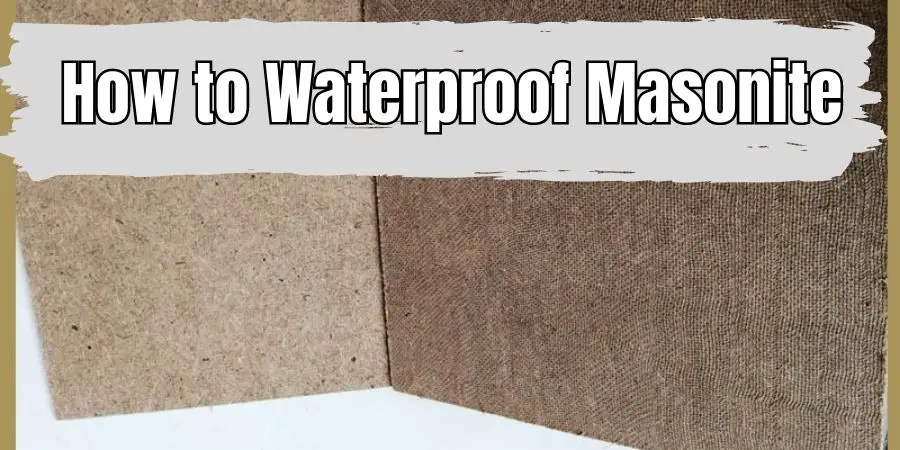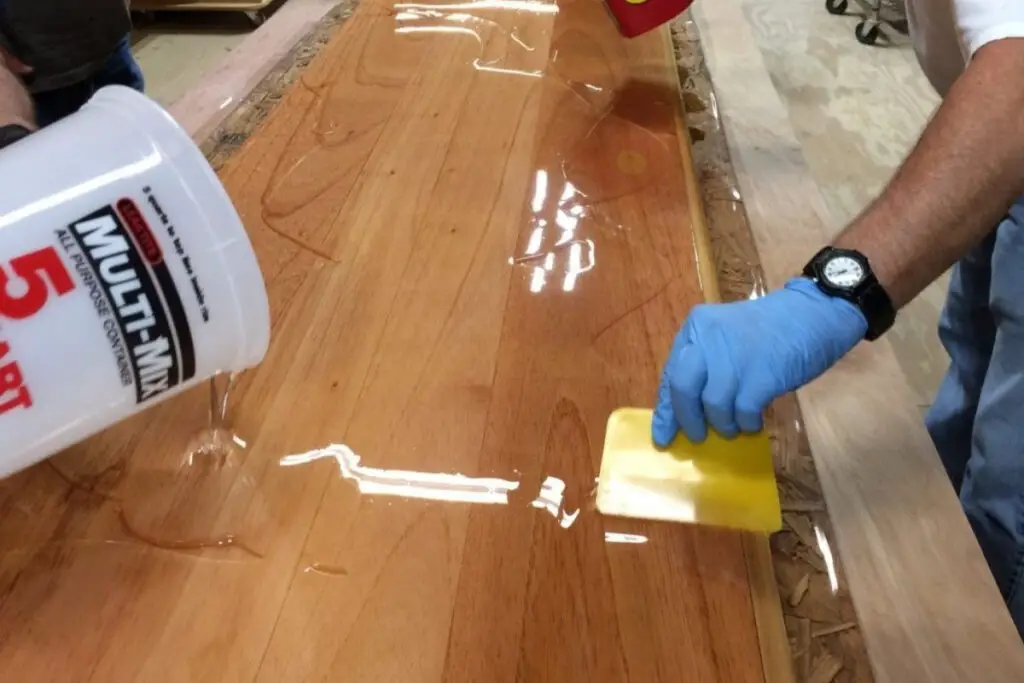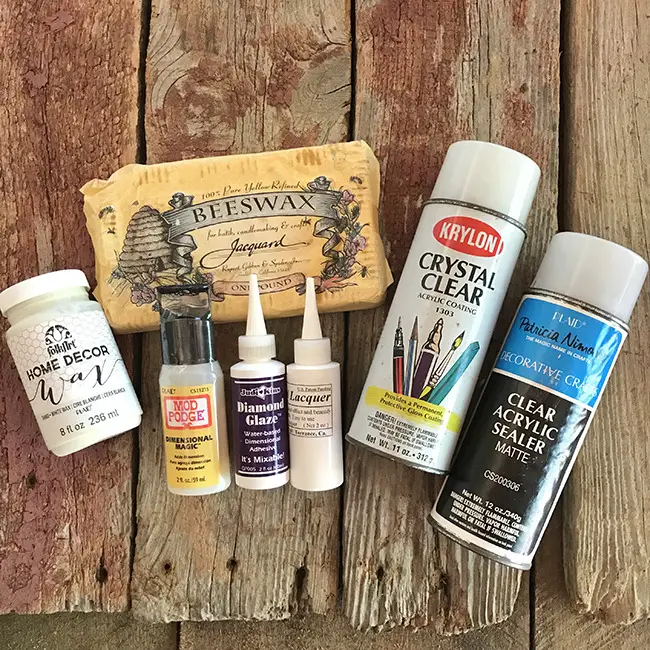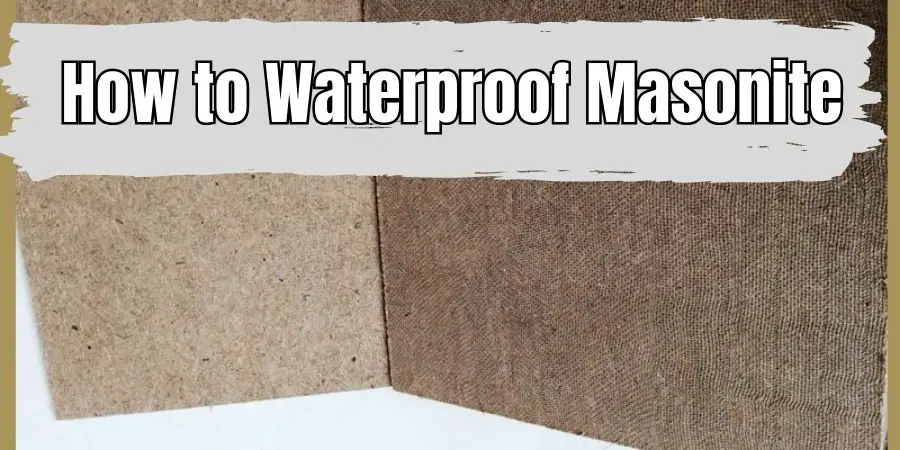Masonite is a type of hardboard made from wood fibers that has been used for a variety of purposes, including as a base for painting and as a substrate for flooring.
However,Masonite panels are not inherently waterproof, but they can be made water-resistant with the right treatment.
Masonite is made from compressed wood fibers, which are susceptible to water damage if they are not properly protected.
So, if you’re planning to use Masonite in a wet or damp environment, it’s important to take steps to waterproof it.
To waterproof Masonite effectively, follow these key steps:
- Understand Masonite: Know that Masonite is an engineered wood product used in construction.
- Start with Cleaning: Thoroughly clean the Masonite to remove dirt, grime, and mold.
- Select the Right Sealant: Choose a high-quality exterior-grade sealant or paint that provides moisture and UV protection.
- Apply Sealant Properly: Prime the surface, apply multiple even coats, and ensure each coat is dry before applying the next.
- Focus on Edges and Joints: Pay extra attention to sealing the edges and joints, as they are more vulnerable to moisture.
Table of Contents
6 Ways to Waterproof Masonite

Method 1: Seal with Epoxy Resin

One of the most effective ways to waterproof Masonite is to seal it with epoxy resin.
This method creates a hard, protective layer that can withstand exposure to water and other liquids.
Here are the steps to follow:
Clean the surface of the Masonite thoroughly. Use a clean cloth or sponge to remove any dirt, dust, or debris.
Mix the epoxy resin according to the manufacturer’s instructions. Be sure to wear gloves and a mask to protect yourself from the fumes.
Apply the epoxy resin to the Masonite using a brush or roller. Be sure to cover the entire surface evenly.
Allow the epoxy resin to dry completely. This can take anywhere from a few hours to a day, depending on the temperature and humidity.
Sand the surface of the Masonite lightly with a fine-grit sandpaper to smooth out any bumps or imperfections.
Apply a second coat of epoxy resin, following the same steps as before. This will provide additional protection against water damage.
Method 2: Paint with Acrylic Sealer

Another way to waterproof Masonite is to paint it with an acrylic sealer.
This method creates a water-resistant barrier that can help protect the Masonite from moisture.
Here’s how to do it:
Clean the surface of the Masonite thoroughly. Use a clean cloth or sponge to remove any dirt, dust, or debris.
Apply a coat of acrylic sealer to the Masonite using a brush or roller. Be sure to cover the entire surface evenly.
Allow the acrylic sealer to dry completely. This can take anywhere from a few hours to a day, depending on the temperature and humidity.
Sand the surface of the Masonite lightly with a fine-grit sandpaper to smooth out any bumps or imperfections.
Apply a second coat of acrylic sealer, following the same steps as before. This will provide additional protection against water damage.
Method 3: Apply Polyurethane Varnish
A third way to waterproof Masonite is to apply a polyurethane varnish.
This method creates a durable, water-resistant coating that can help protect the Masonite from moisture.
Here’s how to do it:
Clean the surface of the Masonite thoroughly. Use a clean cloth or sponge to remove any dirt, dust, or debris.
Apply a coat of polyurethane varnish to the Masonite using a brush or roller. Be sure to cover the entire surface evenly.
Allow the polyurethane varnish to dry completely. This can take anywhere from a few hours to a day, depending on the temperature and humidity.
Sand the surface of the Masonite lightly with a fine-grit sandpaper to smooth out any bumps or imperfections.
Apply a second coat of polyurethane varnish, following the same steps as before. This will provide additional protection against water damage.
Method 4: Apply Silicone Sealant
Silicone sealant is another effective way to waterproof Masonite.
This method creates a flexible, water-resistant barrier that can help protect the Masonite from moisture.
Here’s how to do it:
Clean the surface of the Masonite thoroughly. Use a clean cloth or sponge to remove any dirt, dust, or debris.
Apply a bead of silicone sealant along the edges and seams of the Masonite, using a caulking gun or your fingers.
Smooth out the silicone sealant with a damp cloth or your finger, making sure to fill in any gaps or holes.
Allow the silicone sealant to dry completely. This can take anywhere from a few hours to a day, depending on the temperature and humidity.
Apply a second bead of silicone sealant, following the same steps as before. This will provide additional protection against water damage.
Method 5: Use Waterproofing Spray
Waterproofing spray is a quick and easy way to waterproof Masonite.
This method creates a water-resistant coating that can help protect the Masonite from moisture.
Here’s how to do it:
Clean the surface of the Masonite thoroughly. Use a clean cloth or sponge to remove any dirt, dust, or debris.
Shake the waterproofing spray can well, and then hold it about 6 inches away from the Masonite.
Spray a light, even coat of the waterproofing spray over the surface of the Masonite.
Allow the waterproofing spray to dry completely. This can take anywhere from a few hours to a day, depending on the temperature and humidity.
Apply a second coat of waterproofing spray, following the same steps as before. This will provide additional protection against water damage.
Method 6: Use Marine Varnish
If you need to waterproof Masonite for use in a marine environment, then marine varnish may be the way to go.
Marine varnish is a durable, water-resistant coating that is designed to withstand exposure to saltwater and other harsh conditions.
Here’s how to use it:
Clean the surface of the Masonite thoroughly. Use a clean cloth or sponge to remove any dirt, dust, or debris.
Apply a coat of marine varnish to the Masonite using a brush or roller. Be sure to cover the entire surface evenly.
Allow the marine varnish to dry completely. This can take anywhere from a few hours to a day, depending on the temperature and humidity.
Sand the surface of the Masonite lightly with a fine-grit sandpaper to smooth out any bumps or imperfections.
Apply a second coat of marine varnish, following the same steps as before. This will provide additional protection against water damage.
Best sealers to waterproof masonite
Polyurethane Sealer
Polyurethane sealer is a popular choice for sealing Masonite, as it provides a durable, water-resistant finish that can help protect the material from moisture and other types of damage.
It also dries clear, which makes it a good choice if you want to maintain the natural appearance of the Masonite.
Epoxy Sealer
Epoxy sealer is another option to consider, particularly if you need a very strong and durable finish. Epoxy creates a hard, glossy coating that is highly resistant to water, chemicals, and abrasion.
It’s a bit more challenging to work with than polyurethane, but it can provide superior protection in some situations.
Acrylic Sealer
Acrylic sealer is a good choice if you’re looking for a sealer that is easy to apply and dries quickly.
It provides a clear, matte finish that can help protect the Masonite from moisture and other types of damage.
However, it may not be as durable as polyurethane or epoxy, so it may not be the best choice for high-traffic or high-moisture areas.
Shellac Sealer
Shellac sealer is a traditional choice that has been used for centuries to seal wood and other materials.
It creates a hard, glossy finish that is highly resistant to water and other types of damage.
However, it can be a bit more challenging to work with than some other types of sealers, and it may not be as durable over the long term.





